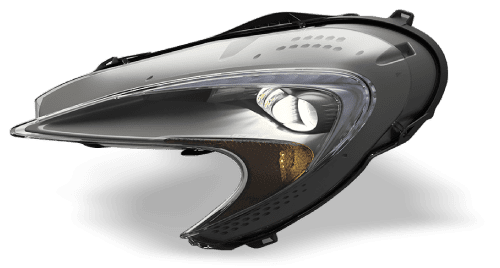
The Difference Between Standard and Sequential Turn Signals

Turn signals are one of the most fundamental safety features on any vehicle. They communicate a driver’s intention to turn or change lanes, preventing countless accidents every day.
For decades, the simple, flashing light of a standard turn signal was the universal language on the road.
But now, a new style is gaining traction. With its flowing, animated light pattern, the sequential signal offers a modern twist on a classic feature.
This guide will explain the differences between standard and sequential turn signals, exploring how they work, their pros and cons, and more. By the end, you’ll understand each type and be better equipped to decide which is right for your vehicle.
What Are Standard Turn Signals?
A standard turn signal, also known as a blinking or flashing signal, is the type most drivers are familiar with.
When you activate the turn signal lever in your car, a single light bulb or a cluster of LEDs at the corresponding corner of the vehicle begins to flash on and off at a steady rhythm. This continues until you complete your turn and the steering wheel straightens, or you manually disengage the signal.
The technology is straightforward.
A small device called a flasher unit or relay interrupts the electrical circuit to the bulb, causing it to blink. This simple, effective design has been the industry standard for generations.

Advantages of Standard Turn Signals
So, what are the benefits of choosing standard turn signals?
Cost-Effective: Their simple design makes them inexpensive to manufacture and replace, keeping repair costs low for vehicle owners.
Universal Recognition: Virtually every driver on the planet immediately understands what a standard flashing turn signal means.
Reliability: With fewer complex parts, there is less that can go wrong. The technology is tried and true.
Disadvantages of Standard Turn Signals
Let’s highlight some of the issues with the average turn signal.
Basic Visibility: While effective, the simple on-off pattern is less eye-catching than modern alternatives, especially in cluttered urban environments or adverse weather.
Dated Appearance: On newer, sleeker vehicles, the look of a standard blinking bulb can seem outdated compared to more advanced lighting technologies like LEDs.
What Are Sequential Turn Signals?
Sequential turn signals introduce a touch of animation to your car’s lighting.
Instead of a single light flashing on and off, a series of individual LEDs light up in succession, creating a flowing pattern that moves from the inside of the vehicle outward in the direction of the turn. This cascading effect is sometimes referred to as a “scrolling” or “dynamic” turn signal.
This effect is achievable via a strip of LEDs controlled by a microprocessor.
The controller illuminates each LED one after the other with a slight delay, creating the illusion of smooth motion. This technology first appeared on high-end luxury cars but is now becoming more common across various vehicle price points.
Advantages of Sequential Turn Signals
Now, let’s consider an important question; why should you install sequential turn signals?
Enhanced Visibility: The animated, directional movement is more dynamic and attention-grabbing than a standard blinking light, which can help draw the attention of other drivers more effectively.
Modern Aesthetic: Sequential signals provide a sleek, high-tech look that complements modern vehicle designs.
Disadvantages of Sequential Turn Signals
While sequential turn signals offer modern styling and improved visibility, they aren’t without their downsides. Before upgrading, it’s important to consider the potential drawbacks associated with this technology.
Higher Cost: The complex electronics and multiple LEDs make sequential turn signals more expensive to produce and replace than their standard counterparts.
Regulatory Ambiguity: As a newer technology, the specific regulations governing them can sometimes be less clear, although they are broadly legal in most places.
Navigating Regulatory Ambiguity
Most reputable aftermarket sequential turn signal kits are designed to comply with federal regulations. However, state laws can sometimes add another layer of rules
It is always a good idea to check your specific state’s vehicle code or consult with an installation professional if you have concerns. For the vast majority of drivers, installing a properly designed sequential turn signal system will not cause any legal issues.
Core Technical and Visual Differences
The biggest differences between standard and sequential turn signals are their operation and visual output.
Signal Technology
Standard turn signals typically use a single incandescent bulb or a static group of LEDs powered through a simple on/off flasher relay.
Sequential turn signals rely on a series of individually controlled LEDs managed by a microcontroller that dictates the timing and order of illumination.
Visual Impact
The average headlight will produce a repetitive, static flash.
The entire light assembly illuminates and darkens at once. This differs significantly from the sequential design, which creates a fluid, directional light pattern.
A sequential light appears to “flow” or “sweep” across the lamp assembly, providing a more dynamic visual cue.

Considering an Upgrade to Sequential Signals
If the modern look and enhanced visibility of sequential turn signals appeal to you, upgrading is a popular modification. Many aftermarket options are available for a wide range of vehicle makes and models. These kits range from simple plug-and-play replacements for your existing lights to more complex systems that may require professional help.
Here are some resources to get you started:
DIY Installation: For those comfortable with vehicle electronics, many kits come with detailed instructions. Online forums and YouTube tutorials for your specific vehicle model can be invaluable resources.
Professional Installation: If you’re not confident in doing the work yourself, a local auto customization shop or a trusted mechanic can handle the installation for you, ensuring everything is wired correctly and functions safely.
Driving Forward with Style and Safety
Sequential turn signals undoubtedly bring a stylish and functional edge to vehicle lighting, but it’s essential to weigh their disadvantages before making a final decision. Whether you’re drawn to enhanced visibility or sleek design, ensuring compatibility with your vehicle and understanding local regulations are key steps in making an informed choice.
If you’re considering upgrading to sequential turn signals, take the time to compare trusted brands and consult with knowledgeable professionals. Make your next drive not only safer but also more stylish—start exploring your options today!
You can start browsing high-quality LED turn signal lights right now to bring a modern aesthetic and performance standard to your vehicle.


